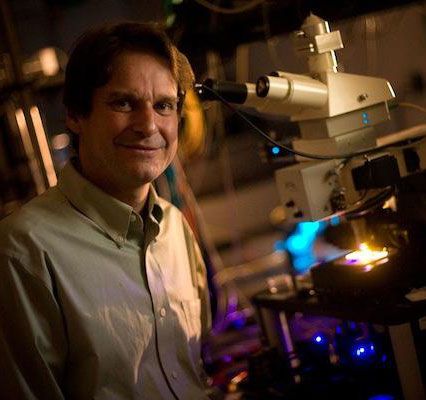Scientists at Lehigh University, in collaboration with Lawrence Berkeley National Laboratory, have demonstrated the fabrication of what they call a new class of crystalline solid by using a laser heating technique that induces atoms to organize into a rotating lattice without affecting the macroscopic shape of the solid.
By controlling the rotation of the crystalline lattice, the researchers say they will be able to make a new type of synthetic single crystals and “bio-inspired” materials that mimic the structure of special biominerals and their superior electronic and optical properties as well.
The group reported its findings today (Nov. 3) in Scientific Reports, a Nature journal, in an article titled “Rotating lattice single crystal architecture on the surface of glass.” The paper’s lead author is Dmytro Savytskii, a research scientist in the department of materials science and engineering at Lehigh.
The other authors are Volkmar Dierolf, distinguished professor and chair of the department of physics at Lehigh; Himanshu Jain, the T.L. Diamond Distinguished Chair in Engineering and Applied Science and professor of materials science and engineering at Lehigh; and Nobumichi Tamura of the Lawrence Berkeley National Lab in Berkeley, California.
The development of the rotating lattice single (RLS) crystals follows a discovery reported in March in Scientific Reports in which the Lehigh group demonstrated for the first time that a single crystal could be grown from glass without melting the glass.
In a typical crystalline solid, atoms are arranged in a lattice, a regularly repeating, or periodic three-dimensional structure. When viewed from any angle—left to right, up and down, front to back—a crystal-specific periodicity becomes evident. Glass, by contrast, is an amorphous material with a disordered atomic structure.
Because they have no grain boundaries between interconnecting crystals, single-crystal materials often possess exceptional mechanical, optical and electrical properties. Single crystals give diamonds their brilliance and jet turbine blades their resistance to mechanical forces. And the single crystal of silicon of which a silicon chip is made gives it superior conducting properties that form the basis for microelectronics.
The periodicity, or repeating pattern, in a rotating lattice single crystal, said Jain and Dierolf, differs from the periodicity in a typical single crystal.
“We have found that when we grow a crystal out of glass,” said Jain, “the periodicity does not result the some way. In one direction, it looks perfect, but if you turn the lattice and look at it from a different angle, you see that the whole structure is rotating.”
“In a typical single-crystal material,” said Dierolf, “once I figure out how the pattern repeats, then, if I know the precise location of one atom, I can predict the precise location of every atom. This is possible only because single crystals possess a long-range order.
“When we grow an RLS crystal out of glass, however, we have found that the periodicity does not result the some way. To predict the location of every atom, I have to know not just the precise location of a particular atom but the rotation angle of the lattice as well.
“Thus, we have to slightly modify the textbook definition of single crystals.”
Read the full story at the Lehigh University News Center.
-Kurt Pfitzer is Manager of Editorial Services with Lehigh University's Office of Communications and Public Affairs.


